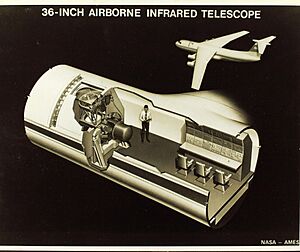Infrared telescope facts for kids
An infrared telescope is a special kind of telescope. It helps scientists see things in space by detecting infrared radiation. You can think of infrared radiation as heat energy. Everything in the universe that isn't super-cold (at absolute zero) gives off some kind of energy. Infrared light is one type of this energy, and it's part of the electromagnetic spectrum.
Contents
Seeing the Universe in Heat
Astronomers use many different types of telescopes. Each type helps them see different kinds of energy coming from space. For example, some telescopes see gamma rays, others see x-rays, and some see ultraviolet light. We also have telescopes that see regular visible light, which is what our eyes can see. Infrared telescopes are unique because they focus on the heat energy.
Why Infrared is Different
Infrared light is special because it can show us things that are hidden from regular visible light. For example, it can pass through clouds of dust and gas in space. This lets astronomers see newborn stars or planets forming inside these dusty clouds. It also helps them study cooler objects that don't give off much visible light, like asteroids or cold, dusty clouds between stars.
Challenges for Infrared Telescopes
One big problem for infrared telescopes on Earth is our planet's atmosphere. The air around us, especially water vapor, absorbs a lot of infrared light. This means that much of the heat energy from space doesn't reach telescopes on the ground.
Getting Above the Atmosphere
To get the best views, infrared telescopes often need to be placed very high up or even in outer space.
- Some are put on tall mountains where the air is thinner.
- Others are carried by special airplanes, like SOFIA, which fly above most of the water vapor.
- The very best infrared telescopes are launched into space. This lets them see all the infrared light without any interference from Earth's atmosphere. This is especially important for seeing longer wavelengths of infrared light, which come from cooler objects.
Images for kids



